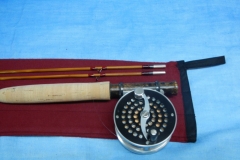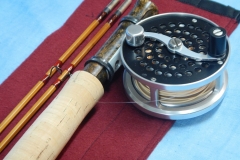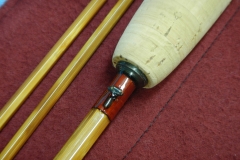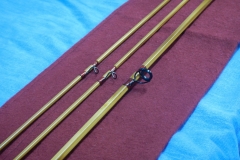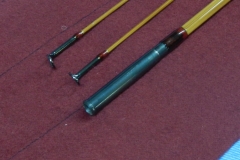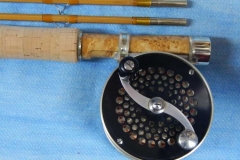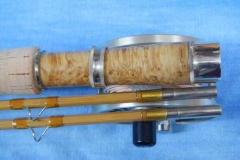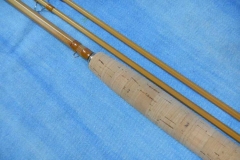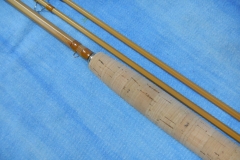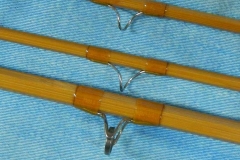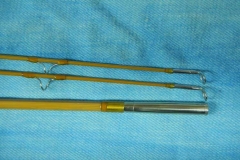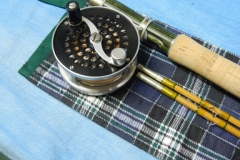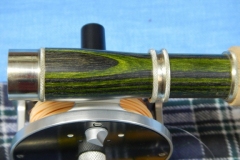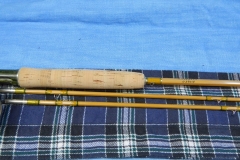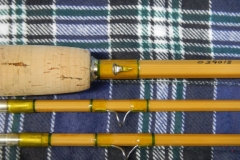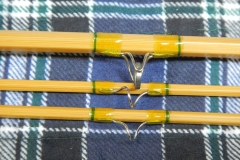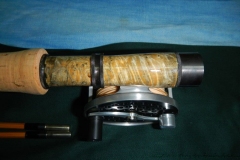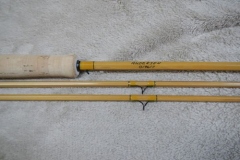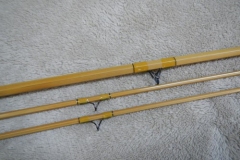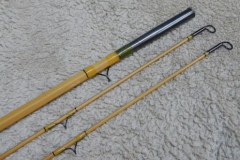Custom Rods
Custom Builds
As mentioned in the New Rods List, I also make a number of custom rods for customers who wish to wait for a while. From time to time I’ll add a rod or two to this link.
2012 Rod #1
The rod pictured below is the third rod for this customer. He and I discussed what he wished in a rod and fittings. This is the result. The result is a rod 6’6″ three weight and was constructed with mildly flamed cane, high grade cork, titanium snake guides, black ceramic Hopkins and TollwayHolloway stripper and a black H&H hook keeper. The reel seat was made of maple stained very dark and completed with a hand -rubbed varnish finish. In keeping this the overall look, the customer chose red wrappings c/w 2 turn black trim wraps. The nickel silver ferrules, hosel and skeleton reel seat bands are all blued. The reel shown was a very much appreciated gift from another customer.
2012 Rod #2
This is the first rod for this customer. His wife booked a rod in the build line last Xmas and although we attempted many times to get together to select tapers and fittings but the weather and roads always won. Finally we got a chance to meet, exchange ideas on what the customer would like. He chose a 7’9″ 5 wt. TU Taper of which I developed and have now made several rods. The rod was fitted with a Andersen Reel seat c/w a Box Alder Burl that complements both the cane color and tan wrappings. The tan wraps are completed with a two turn dark olive trim. The nickel silver fitting were left bright. The snake guides are Perfection hard chromed with a Hopkins and Holloway tip tops. The strip guide is Mildrum Carbaoly. Like the rod above, the reel shown was a gift from others and is not part of the rod package.
2013 Rod #1
The rod below is the first cane rod for this customer. He chose a green micrata reelseat for his rod The guide wraps chosen were lime green c/w darker green tipping.
2014
There were two “custom” rods made between 2013 – both for me – a 4 and 5 strippers. Both in 7’6″ length of 4 or 5 wright lines. I have used the 4 stripper for several years on southern Alberta Cutthroat. The 5 stripper taper was too stiff for my liking and I’m back plotting a different taper.
For 2015
This is a first rod for this customer. He desired a 8’0″ 5 weight rod for lake fishing and I suggested that he look over Chris Carlin’s Web site for the deflection curves Chis has plotted. see http://www.carlinbamboo.com/essays/deflection.htm After some discussion, the customer decided on a Dickerson 8013 [1949] model. The handle design is patterned after a rod handle he owns and likes. The handle would have required 13 corks so some modification of the cork numbers was required. He chose titanium snake guides, a black carboloy stripped, blued reel seat, hosel and ferrules. The reel seat insert is an impregnated burl that has been dyed and protected by hand rubbed varnish coats. The wrap colours are deeper red c/w 2 turns of black tipping. The ferrule tabs are wrapped with black thread in keeping with the colour of the components.
For 2016/17
With the slowing of Alberta’s economy, the rod orders have fallen off slightly allowing me to spend some time in experimentation.
This year I’m working on my techniques for hollow building a rod. Using the Paul Young Para 15 taper I know well and use often, I expanded the taper to compensate for the hollowing. The hollows are 2″ long followed by a 3/4″ dam. The butt section was hollowed from end to end stopping 8″ from the ferrule whereas the tip was hollowed only for 25 inches or so. The removal of the pith material left a side wall of 0.073″ off power fibers. Power fibers are typically 0.080″ thick. The reel seat insert is mesquite, with all the metal components including stripper guides blued. The snake guides and tip top are black coated titanium plated. A modified full wells grip was chosen. The grip is 6 1/4″ long.
Below are two pictures of the hollowing equipment with the resultant scallops. These pictures are of a 4 strip rod [Quad] that I’m working on now. Got to have it done for the yearly cutthroat trip.
In this case the scallops are similar as the Para 15 rod above with the side wall adjusted to maintain the same sized gluing surface as the rod above. Both of these rods are experimental as there is not a lot of information available on hollowing techniques. Items to be determined include:
1] length of scallops
2] length of dams
3]whether dams are required
4] types of glue
5] areas left without scallops
6] and the big one – compensation of taper to off-set pith removal
The tool below allows adjustment of 0.002″ increments. The power is a Makita router which powers a carbide burr.
